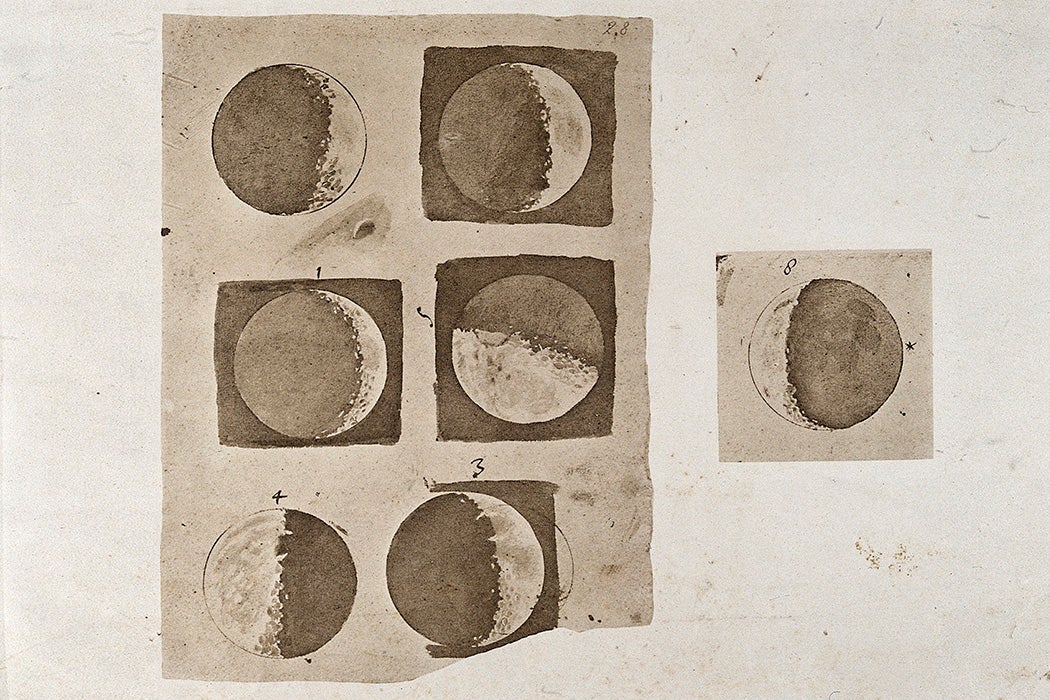Astronaut Bill Anders’s 1968 photo of the Earth rising above the Moon, taken from Apollo 8, the first crewed spacecraft to orbit the Moon, became a landmark in environmental consciousness. Our blue-and-white planet looked so small and fragile in the immensity of space; somebody had better take care of it.
Three-and-a-half centuries earlier, there had been a different dawn of environmental awakening when Galileo Galilei closely examined the Moon through one of the new telescopes. Instead of a perfectly smooth Aristotelian orb, he saw astonishingly familiar mountains and shaded valleys. The topography was, he wrote, “like the face of the Earth itself.”
For scholar Michael Rawson, humanity’s first good look at an extraterrestrial object marks a giant step in environmental imagination, the beginning of “an environmental history of the universe.” Rawson reminds us that the
century after Galileo’s discovery begins to look like a radically transformative period in the way that human beings thought about the natural world, a time when the universe beyond earth was pulled into the realm of environmental thought through a dramatic expansion in humankind’s environmental imagination.
Galileo’s 1610 treatise Sidereus Nuncius (Sidereal Messenger or The Starry Messenger) inspired centuries of thinking about space,including how to get to it, what we would find out there, and then—finally—the actual venturing into space. In realization of that enduring dream, humans and our machines have blasted free of Earth’s gravity, journeying to the Moon, into the solar system, and beyond for half a century now. Meanwhile, our starry messengers include even older radio and television broadcasts; the SETI Institute reports that you’d need a very large antenna to pick up episodes of The Goldbergs and I Love Lucy on a distant planet.
Sidereus Nuncius spread the news rapidly, giving birth to “the first sustained scientific conversation in human history about the environments of other worlds.” With other worldly environments, the possibility of other forms of life was perhaps inevitable. In addition, “it influenced European literature, promoted new interactions between celestial and earth sciences, stimulated colonist thought, and sparked the first serious inquiry into the possibility of space travel.”
Fact and fable were entwined in such speculations. German mathematician and astronomer Johannes Kepler’s concocted what he called a “lunar geography,” mixing cutting-edge science and narration by a demonic tour guide in The Dream (1634). Rawson notes that time has proven “most of Kepler’s deductions about the nature of the moon to be incorrect,” but the work was nonetheless a “tremendous leap in environmental imagination” and a vital forerunner of science fiction.
Weekly Newsletter
Insights about Earth’s geology were superimposed on the Moon and vice-versa as the “experience of one world’s environment shaped knowledge and experience of the other.” Kepler’s majestic yet foreboding lunar mountains may have “presaged the transition to seeing terrestrial mountains as sublime.” English clergyman Francis Godwin’s 1638 publication, The Man in the Moone, postulated a shared ecosystem and shared species; the Moon was where migratory British birds went in winter. Godwin’s narrator gets to the Moon by being pulled by swans. “[S]washbuckler and polymath” Cyrano de Bergerac was a bit closer to the mark in 1657, when he sent his Moon-traveller via fireworks.
The age of European exploration and colonization first incorporated the Moon and then other planets as well. Galileo was akin to Columbus; the Moon was another New World to be conquered. Space was the ultimate frontier. The British, in particular, were quick to jump on the idea of lunar imperialism.
All this literally lunatic thinking resulted in what Rawson calls an environmental imaginary, centered on the idea that
life might be abundant in the universe; that biological relationships could exist between different worlds; that natural processes were similar everywhere; that other worlds might contain vital natural resources; and that extraterrestrial life would be as well adapted to its own environments as terrestrial life was to earth’s.
Although originating in the seventeenth century, this set of environmental ideas still sounds reasonable today.







